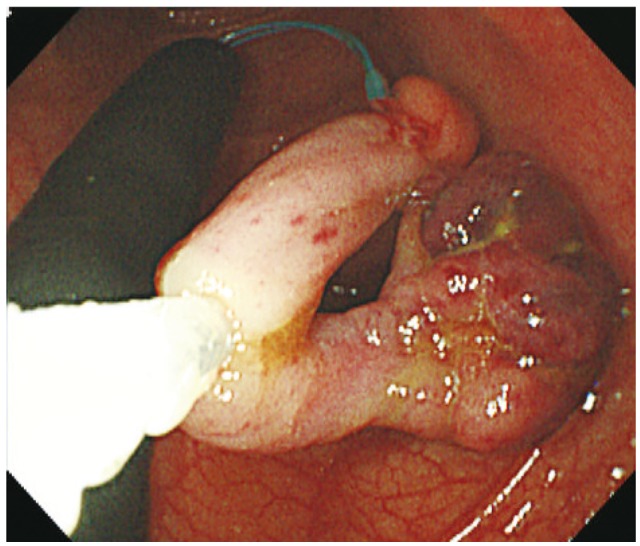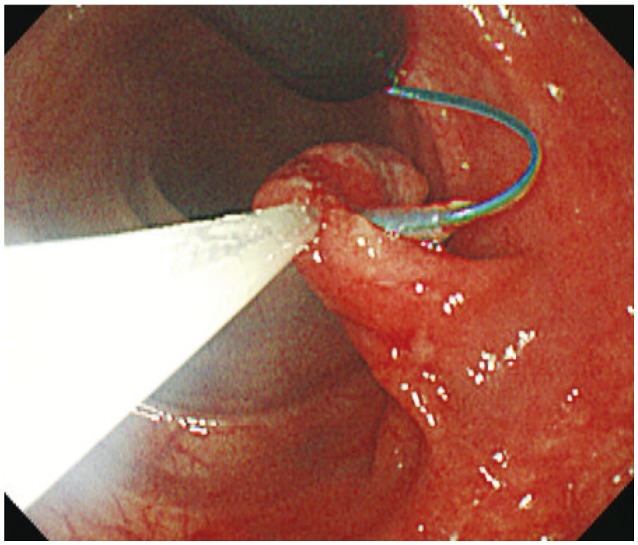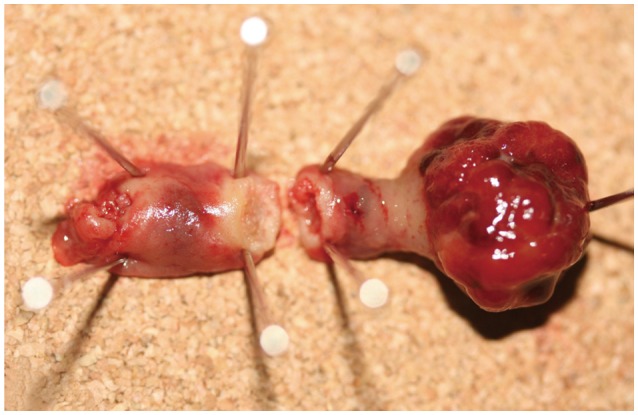The incidence of postpolypectomy hemorrhage ranges from 0.3% to 6.1%, and is the most common complication of polypectomy.1 The risk of bleeding may be especially high after resecting pedunculated polyps because of the presence of a large artery in the stalk.
Bleeding can occur in the immediate postpolypectomy period, or may be delayed up to 29 days.2 Several endoscopic techniques have been developed. In 1989, Hachisu3 developed a detachable snare device that completely stops blood flow in the stalk. While loading the detachable snare, it is important to verify that it is properly attached to the hook wire and smoothly pulled into and then pushed back from the coil sheath without getting stuck.4 A second endoscope-assisted endoscopic submucosal dissection for large colorectal tumors has been reported recently.5-7 Here, we report a case in which an accidently unreleased detachable snare used for colon polypectomy was successfully removed by a second assisting endoscope.
A 40-year-old man underwent screening colonoscopy. A grossly 1.5 cm-sized pedunculated polyp with a 3 cm-long stalk was observed at the distal descending colon. A detachable snare (MAJ-254; Olympus, Tokyo, Japan) was placed around the lower one-third of the stalk. The detachable snare could not be released from the hook wire of the operating part, as the loop of nylon thread appeared to be tightly stuck between the coil sheath and hook wire. Hence, the snare loop and coil sheath were attached to the colon polyp, and the colonoscope could not be retrieved (Fig. 1).
Fig. 1.

The unreleased snare observed by the second assisting endoscope.
A second assisting gastroscope was inserted. The stalk was cutoff with a conventional snare between the snare loop and the polyp head. Cutting of the unreleased detachable loop with hot biopsy forceps and an insulation-tipped diathermic knife was then attempted, but failed. A conventional snare was placed just above the rubber stopper of the detachable snare (Fig. 2), and the detachable snare, which tightly strangulated the stalk, was successfully released from the stalk by cutting at that position, and all the specimens were retrieved (Fig. 3). No complications such as bleeding or perforation were noted during the 2 weeks of follow-up.
Fig. 2.

Snare resection of the stalk just above the rubber stopper.
Fig. 3.

Gross specimen of the removed polyp.
Clinical evidence supports the usefulness of the detachable snare in the management of postpolypectomy bleeding, bleeding from esophageal and gastric varices, and angiodysplasias.4 The detachable snare was developed for the prevention of hemorrhage after the removal of large pedunculated polyps.1 Hence, the most probable reason for the detachable snare not being released was that it got stuck between the coil sheath and hook wire in this case.
Several complications related to the detachable snare have been reported. It became entangled with the polypectomy snare in one patient, and the proper transection of peduncle failed in another patient.8 A slip-off of an endoloop slip-off in five of 53 patients, and delayed bleeding occurred in three of 53 patients, especially those with semipedunculated polyps.8,9
A second gastroscope may easily be inserted up to the descending colon without increasing the patient's discomfort and may efficiently act as another hand by lifting the dissected lesion during the dissection procedure.5-7 In our case, a second endoscope, however, was required for the successful removal of the unreleased snare and colon polyp, as the first endoscope was unsuccessful.
Footnotes
The authors have no financial conflicts of interest.
References
- 1.Macrae FA, Tan KG, Williams CB. Towards safer colonoscopy: a report on the complications of 5000 diagnostic or therapeutic colonoscopies. Gut. 1983;24:376–383. doi: 10.1136/gut.24.5.376. [DOI] [PMC free article] [PubMed] [Google Scholar]
- 2.Singaram C, Torbey CF, Jacoby RF. Delayed postpolypectomy bleeding. Am J Gastroenterol. 1995;90:146–147. [PubMed] [Google Scholar]
- 3.Hachisu T. A new detachable snare for hemostasis in the removal of large polyps or other elevated lesions. Surg Endosc. 1991;5:70–74. doi: 10.1007/BF00316840. [DOI] [PubMed] [Google Scholar]
- 4.Rengen MR, Adler DG. Detachable snares (endoloop) Tech Gastrointest Endosc. 2006;8:12–15. [Google Scholar]
- 5.Uraoka T, Saito Y, Matsuda T, et al. Endoscopic indications for endoscopic mucosal resection of laterally spreading tumours in the colorectum. Gut. 2006;55:1592–1597. doi: 10.1136/gut.2005.087452. [DOI] [PMC free article] [PubMed] [Google Scholar]
- 6.Uraoka T, Kato J, Ishikawa S, et al. Thin endoscope-assisted endoscopic submucosal dissection for large colorectal tumors (with videos) Gastrointest Endosc. 2007;66:836–839. doi: 10.1016/j.gie.2007.04.028. [DOI] [PubMed] [Google Scholar]
- 7.Fusaroli P, Grillo A, Zanarini S, Caletti G. Usefulness of a second endoscopic arm to improve therapeutic endoscopy in the lower gastrointestinal tract. Preliminary experience: a case series. Endoscopy. 2009;41:997–1000. doi: 10.1055/s-0029-1215190. [DOI] [PubMed] [Google Scholar]
- 8.Katsinelos P, Kountouras J, Paroutoglou G, et al. Endoloop-assisted polypectomy for large pedunculated colorectal polyps. Surg Endosc. 2006;20:1257–1261. doi: 10.1007/s00464-005-0713-5. [DOI] [PubMed] [Google Scholar]
- 9.Matsushita M, Hajiro K, Takakuwa H, et al. Ineffective use of a detachable snare for colonoscopic polypectomy of large polyps. Gastrointest Endosc. 1998;47:496–499. doi: 10.1016/s0016-5107(98)70251-2. [DOI] [PubMed] [Google Scholar]


